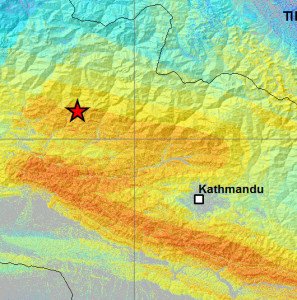Residents across quake-ravaged Nepal face a significant ongoing threat in the form of major landslides, says a New Zealand expert.
 Overseas media including PBS News Hour and NBC News report that the devastating April 25 earthquake triggered many landslides, but aftershocks threaten to cause further slips. Increased rain during the approaching monsoon season will also raise the risk of further landslides. On Tuesday, a landslide from quake-weakened slopes struck a village north of Kathmandu, leaving at least 250 people missing.
Overseas media including PBS News Hour and NBC News report that the devastating April 25 earthquake triggered many landslides, but aftershocks threaten to cause further slips. Increased rain during the approaching monsoon season will also raise the risk of further landslides. On Tuesday, a landslide from quake-weakened slopes struck a village north of Kathmandu, leaving at least 250 people missing.
The SMC collected the following expert commentary on landslides in Nepal.
Dr Tom Robinson, a Post Doctoral Research Associate at University of Canterbury, has modelled the landslide hazard in Nepal, producing preliminary maps of where landslides are likely to have occurred (see below). He comments:
“The steep topography in Nepal along with the intense shaking this earthquake has generated makes landslides a major hazard, particularly in the epicentral region north of Kathmandu. A landslide can travel extremely quickly and wipe out virtually everything in its path. The chances of surviving a direct hit from a landslide are extremely small and a single slide can bury entire towns and villages. They can also block or severely damage roads into affected regions, cutting those locations off completely at the time when they most need access.
“As well as blocking roads landslides can also block rivers, which present probably one of the most severe hazards in Nepal currently. Once a river is blocked it immediately begins to pool behind the landslide, flooding upstream areas and any settlements or infrastructure. These dams often don’t last long, and when they fail that can release a catastrophic flood wave down valley. With monsoon season approaching this is a major hazard as dams can be overwhelmed by heavy rainfall and fail when the water behind has reached its peak height.
“With satellite images being limited by flight paths and weather conditions, landslide modelling immediately after the event has enabled us to rapidly identify areas where major landsliding is expected. This can help prioritise search and rescue zones on the ground as well as divert satellites to look at the regions of most concern first.
“The models being used are based on previous events in USA, China, Taiwan, and New Zealand. They determine landslide hazard based on the slope angle and position, strength of ground shaking, and proximity to rivers and faults. The models show hazard on a relative scale with values closer to 1 having the highest likelihood of landsliding. Currently the models suggest the slopes between Kathmandu and the epicentre are likely to be the worst affected. This is an emerging field however, and this is the first event these models have been applied to in an emergency situation.”
Landslide Hazard Map based on the model

The model results show the relative landslide hazard for each 60mx60m cell on a scale from 0-1. A value of 1 represents cells that, compared to the rest of the affected area, are almost certain to produce landslides. A value of 0 represents a cell that, compared to the rest of the affected area, are almost certain not to produce a landslide. Values between 0 and 1 show the relative likelihood for that cell.
The model output shows landslide hazard. It is possible for a cell to have high hazard (value close to 1) and not produce a landslide in this event. Similarly a cell could have low hazard (value close to 0) and still produce a landslide. It is expected however that the majority of landslides will be located in the highest hazard values. In general, the areas with values >0.7 (yellow or warmer on the colour scale) are where the most intense landsliding would be expected.
Affected area is estimated from the area covered by 20% of highest hazard values, which in the test events has corresponded the region of most intense landsliding.
Source: Robinson TR, Preliminary landslide hazard estimates for the M7.8 Nepal earthquake, 25/4/2015. Department of Geological Sciences, University of Canterbury.